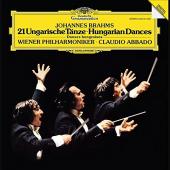Brahms: Hungarian Dances
Label: DG Catalog: 4106151 Format: LP AbbadoThere is a special relationship, running right through the work of Brahms, between his style of composition for orchestra and his style of composition for piano. While for some composers Berlioz is an extreme example the colours and timbres of the instruments of the orchestra constitute an integral factor in their musical invention, Brahms belongs to the opposing school, in that the piano, his own instrument, was always at the root of his musical conceptions. He thought , so to speak, pianistically. On the other hand, as early as 1853, when he was only twenty, his works for piano impressed Robert Schumann as veiled symphonies : that is to say, they have a power which demands in some respects the apparatus of a symphony orchestra for realization. This inherent tension affected his entire output, so that his work in each medium benefits to some extent from the pull exerted by the other. It is the less surprising, therefore, that several of his works lead a double existence, of which it is impossible to say that either version is only an arrangement of the other, and listeners are entirely free to decide which they prefer. The Hungarian Dances are one such work. Brahms published them as piano duets in two sets (nos. 1 10 in 1869 and nos. 11 21 in 1880). But they owe their real fame and they are among his most popular works to the orchestral versions, in which the music reveals its brilliance more fully than in the piano versions. This is due not simply to the greater variety of colour which an instrumental ensemble gives, but also to specific effects which are inevitably more subdued on the piano: the typical string tremolos, for example, the rapid crescendos and diminuendos, or the rhythmic accents which are an important characteristic of the Hungarian idiom. The ancestor of these works of Brahms is not, of course, real Hungarian folk music: it was not until the early twentieth century that that became the subject of serious study, by Bartók, Kodály and others. Rather the line of descent is from the captivating sound-world of gypsy music, through the music of Haydn s and Schubert's day, where it had become a favourite means of colouration with the tag alia ungarese . The idiom of that ancestry, though symphonically stylized, remains audible not only in the sound of Brahms s dances but also in the atmosphere. They vary in mood between high-spirited vitality and melancholia. For the most part Brahms used existing gypsy melodies, which he had collected since his youth, but a few are his own invention. The first set, nos. 1-10, has on the whole the livelier tunes, while melancholy is more prevalent in the second set. The music owes much of its unique character to the agogic fluctuations, the switch from restraint to explosive energy, the alternation of mounting tension and relaxation. At the same time the score permits, indeed, it demands a great degree of creative freedom from interpreters; ever new melodies and motivic relationships succeed each other in continually changing lights, which makes every performance of the Hungarian Dances a tour de force of musicianship. Volker Scherliess Recorded in the Sofiensaal, Vienna by kind permission of the Decca Record Co. Ltd., London Recordings: Wien, Sofiensaal, 6 / 1982 Produced by Rainer Brock Recording Engineer (Tonmeister): Klaus Hiemann Editing: Christopher Alder  Price: $35.98 Price: $35.98 |












